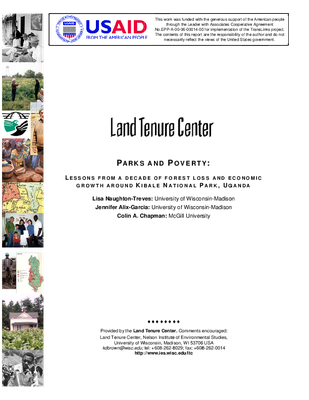Parks and Poverty: Lessons from a decade of forest loss and economic growth around Kibale National Park, Uganda
ABSTRACT: Field data linked to Landsat ETM and ASTER image analysis reveals the patterns and biodiversity impacts of deforestation in western Uganda between 1995 and 2006. Communal forest patches were reduced by nearly half during this period and we observed marked declines in species richness of both canopy level trees and primates. Deforestation was significantly slower within Kibale National Park where commercial forest extraction and agricultural clearing were prohibited. Yet a bad decade for the forest proved a prosperous one for most local residents. Longitudinal data for 252 households show substantial improvements in welfare indicators, with the greatest increases found among those with the highest initial assets; as a result wealth inequalities increased over time. Nearly a quarter of households sold land, an economic strategy of last resort in rural Uganda, and 10% lost their land altogether. The risk of land loss amongst the poor was inversely correlated with proximity to the park, initial farm size, and decline in communal forests. We conclude the current disproportionate presence of poor households at the edge of the park does not signal that the park is a poverty trap.
https://biodiversitylinks.org/projects/completed-projects/translinks/translinks-2010/land-tenure-center/Paper_ParksAndPovertyUganda.pdf/view
https://biodiversitylinks.org/projects/completed-projects/translinks/translinks-2010/land-tenure-center/Paper_ParksAndPovertyUganda.pdf/@@download/image/image.png
File
Parks and Poverty: Lessons from a decade of forest loss and economic growth around Kibale National Park, Uganda
Author(s):
Lisa Naughton-Treves,
Jennifer Alix-Garcia,
Colin A. Chapman
Publication Date: 2010
Location: Kibale National Park, Uganda
DOWNLOAD FILE
ABSTRACT: Field data linked to Landsat ETM and ASTER image analysis reveals the patterns and biodiversity impacts of deforestation in western Uganda between 1995 and 2006. Communal forest patches were reduced by nearly half during this period and we observed marked declines in species richness of both canopy level trees and primates. Deforestation was significantly slower within Kibale National Park where commercial forest extraction and agricultural clearing were prohibited. Yet a bad decade for the forest proved a prosperous one for most local residents. Longitudinal data for 252 households show substantial improvements in welfare indicators, with the greatest increases found among those with the highest initial assets; as a result wealth inequalities increased over time. Nearly a quarter of households sold land, an economic strategy of last resort in rural Uganda, and 10% lost their land altogether. The risk of land loss amongst the poor was inversely correlated with proximity to the park, initial farm size, and decline in communal forests. We conclude the current disproportionate presence of poor households at the edge of the park does not signal that the park is a poverty trap.



